Live
- Irrigation projects: BRS fires failure salvo against TG govt
- New Bhadrachalam bridge over Godavari set to open
- Top officials of TS, AP hold joint meet to ensure hassle-free polls
- Congress’ farmers declaration and guarantees are bogus: Kishan Reddy
- VIP darshans suspended at Ayodhya Ram Mandir Trust amid Sri Rama Navami
- Guidelines being framed for loan waiver
- TS to implement farmers loan waiver scheme by Aug 15
- 1961 celestial wedding song mesmerises even now
- Knowledge Nation Law Centre: A beacon of excellence in legal education
- CM urges Goa counterpart to rehabilitate Kannadigas
Just In

Web-based learning tools can help deepen science knowledge among struggling pupils, and ease the science literacy gap for underachieving students, according to a study published on Monday. Researchers at University of Oregon in the US introduced four interactive online science units, which students and teachers accessed with computers or tablets, into 13 middle schools in two US states.
Washington: Web-based learning tools can help deepen science knowledge among struggling pupils, and ease the science literacy gap for underachieving students, according to a study published on Monday. Researchers at University of Oregon in the US introduced four interactive online science units, which students and teachers accessed with computers or tablets, into 13 middle schools in two US states.
The online units were tested in a randomised, controlled trial with over 2,300 students and 71 teachers. While all participating students improved their science knowledge, the results were particularly notable for less able students. Students with learning disabilities improved 18 percentage points on assessments of science knowledge from pre-test to post-test, and English language learners increased 15 percentage points.
Pupils taught the same content with traditional methods, such as textbooks, showed only 5-point gains. The results published in the International Journal of Science Education are especially important given that students with learning disabilities and English language learners have been historically marginalised in science, technology, engineering, and mathematics (STEM) fields, researchers said.
Despite recent gains, a wide educational attainment gap remains for these students, making them less likely than Caucasian and Asian pupils to complete science coursework in school and pursue STEM careers, they said. "These significant findings demonstrate that the online curriculum was effective in improving science knowledge for students who struggle with science," said Fatima Terrazas Arellanes of the University of Oregon.
"Well-designed instructional technology really works to lessen the science literacy gap among diverse groups of learners.
"Technology offers an engaging and motivating environment for learning, and we are just beginning to understand how we can use it effectively to support students with learning disabilities and English language learners," said Arellanes, principal investigator of the project.
The online units were structured with lessons and activities like textbooks, but the content was much more interactive. Guided by their teachers, students learnt science through watching videos, playing educational games, conducting virtual experiments, and collaborating with their classmates.
The content was especially beneficial to students who struggle thanks to embedded eText supports, such as text-to-speech (hearing online text read aloud), pop-up vocabulary definitions, interactive diagrams, digital note-taking, and captioned videos.

© 2024 Hyderabad Media House Limited/The Hans India. All rights reserved. Powered by hocalwire.com







